| Saturday, December 01, 2007 |
| The China Chronicles - Urumqi |
Now - where were we? Sorry for the break in China blogging, but I was busy showing slides to my family over the Holiday and I've been really busy with League of Women Voter activities since I got back this week.
The last installment had us wrapping up a visit to Turpan, the lowest, hottest, driest place in China. From there, we headed north through the Flaming Mountains and the Gobi desert to the capital city of Xinjiang Province to Urumqi, a city of about two million or so people. Urumqi is the largest city in northwestern China. It also has the dubious distinction of being the most landlocked city on earth. It is physically the most remote city from any open body of water. The only reason we traveled to Urumqi is that its airport is the only way to get to Kashgar, our destination of choice, on the western border of China with Pakistan, Khyrgyztan and Turkmenistan. It did have some things to offer however, including a nice drive from Turpan to Urumqi on the new highway that traces the original route of the Silk Road. Along the way, we traveled next to a large salt flat lake, where the Chinese have erected the largest wind farm in China. It was pretty spectacular.
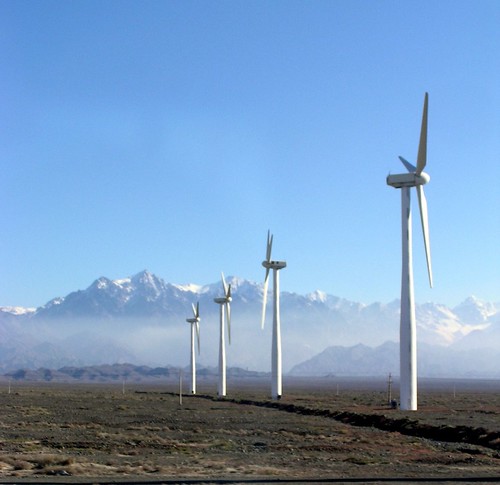
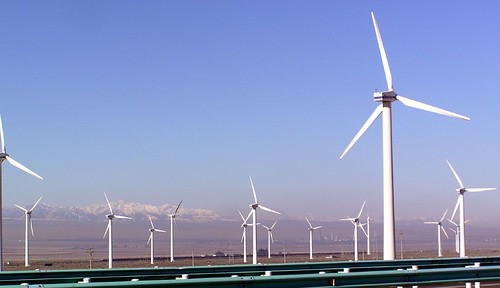
Once in Urumqi, we spent the morning touring the museum there, which is known for its collection of Tarim mummies. Now get this - some of these mummies are over 4,000 years old, and they are EUROPEAN. Yep - red hair, blue eyes, long noses. You weren't permitted to take pictures of them, but they are in spectacular condition, and to imagine that European nomads had managed to travel this far over 4,000 years ago is really mind blowing. It's worth clicking through to the Wiki link.
The other interesting exhibit was a large series of displays promoting all the different ethnic tribes that live in China. This was interesting for two reasons: (1) the Chinese government has done a pretty effective job of wiping out many of these ethnic groups, and still has some pretty oppressive tactics going on with respect to Tibetans, Uyghurs, Hami, and other Chinese minorities, and (2) because there is a clear "unification" process going on in China in respect to absorbing these minorities into the mainstream Han Chinese society with little regard for their traditions and languages.
After the museum, we were bused through downtown past the bazaar where we saw kebob sellers and an open air market bustling with food vendors and grilled meats. We had our noses pressed to the window in anticipation, but they took us to a big hotel for another large Chinese banquet style meal of distinctly Chinese food. Four of us seized an opportunity when our handler wasn't looking to sneak out and go back to the market area, where we enjoyed (at great hygenic risk) a wonderful meal of grilled lamb kebobs, plates of rice pilav with meat and dried fruits, and naan bread with a cold beer at an outdoor table. It was perfect. We had the rest of the afternoon before our flight to roam the markets of Urumqi, and there was a lot to see:
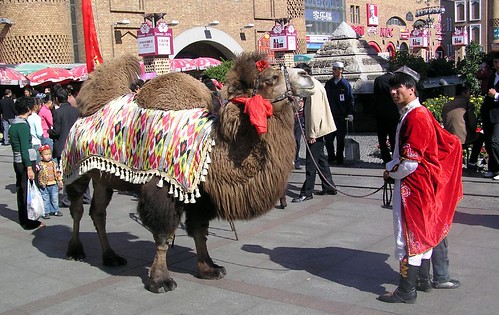
This photo is interesting for a few reasons. One, I'm not used to seeing Bactrian camels in a large city, two, the camel is covered in Atlas Cloth which is indigenous to the Uyghur culture, and three, the camel handler's son was shy and didn't want his picture taken, so he is hiding under his Dad's robes.
Looking above the camel, into the entrance of the marketplace - it was huge.

And you can buy ANYTHING here - I headed straight for a local apothecary shop to see what they had for sale. Deer Horn anyone?
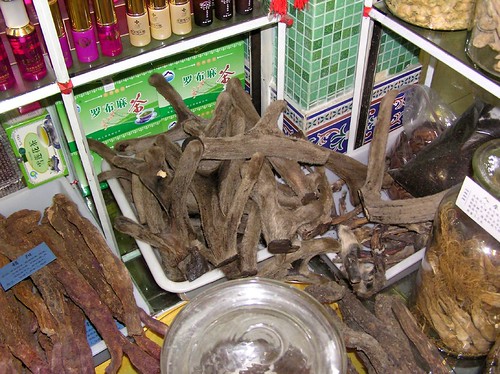
And if that doesn't cure what ails you, then a fine selection of dried worms is just what the doctor ordered:
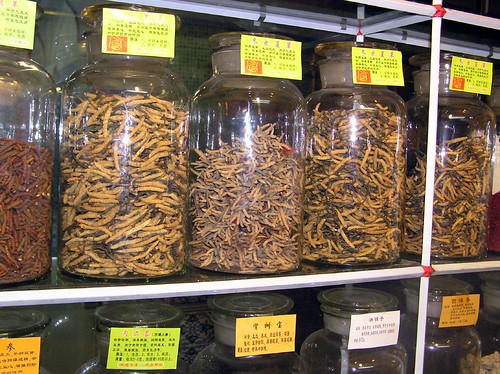
I thought these were the extremes - wait till we get to the markets of Kashgar! Of course, they had plenty of "normal" things to purchase. Including floor after floor and stall after stall of raisins, dried fruits and nuts.
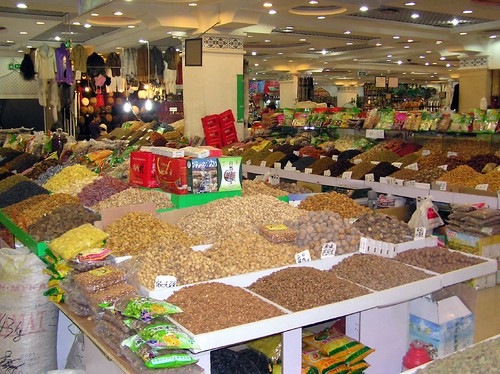
Fresh fruits and bread were available outside the market on the street. Note that this man does not look Chinese at all - he is Uyghur. They are Sunni muslims.
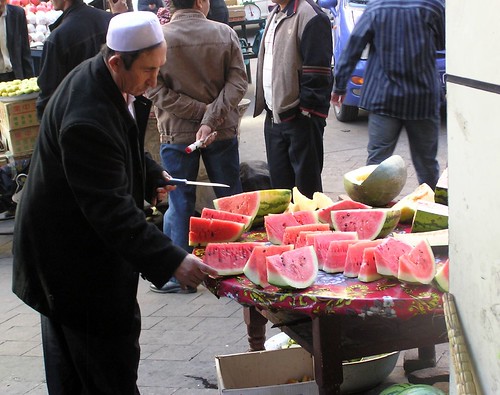
And then there were the Pomegranate Mafia. These guys were dressed really slick and were selling freshly squeezed pomegranate juice. These were by far the largest pomegranates I have ever seen - they were the size of grapefruits.
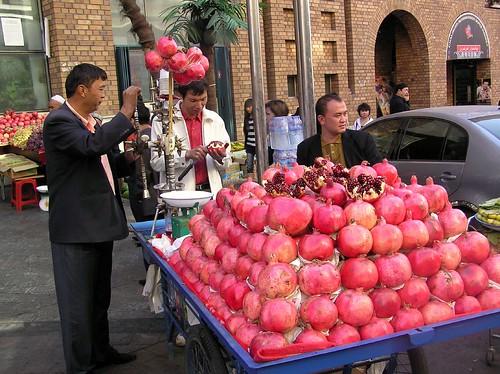
Contrast them to the muslim women selling Naan.
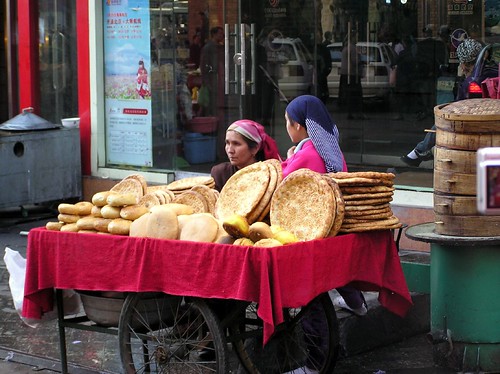
And that bread is SO delicious! It's got garlic, sea salt and rosemary on top, and is just wonderfully fresh and crisp. It's almost cracker like - not doughy like Indian Naan.
That evening, we flew west to Kashgar, and we might as well have flown straight to Afghanistan - it's that different.
Next up: Kashgar |
posted by Broadsheet @ 12:07 PM   |
|
| 1 Editorial Opinions: |
-
As far as I can see from your pictures, it seems to me that the Uighurs can practice their culture, custom and religion freely. They even still wear the same clothes their ancestors wore. They also still speak the same language, except now they can also speak Mandarin. Now, I doubt you will see Native Indians wearing their traditional clothes in downtown Manhattan or Native Ryukyu or Ainu wearing their traditional clothes in Harajuku.
|
| |
| << Home |
| |
|
|


As far as I can see from your pictures, it seems to me that the Uighurs can practice their culture, custom and religion freely. They even still wear the same clothes their ancestors wore. They also still speak the same language, except now they can also speak Mandarin. Now, I doubt you will see Native Indians wearing their traditional clothes in downtown Manhattan or Native Ryukyu or Ainu wearing their traditional clothes in Harajuku.